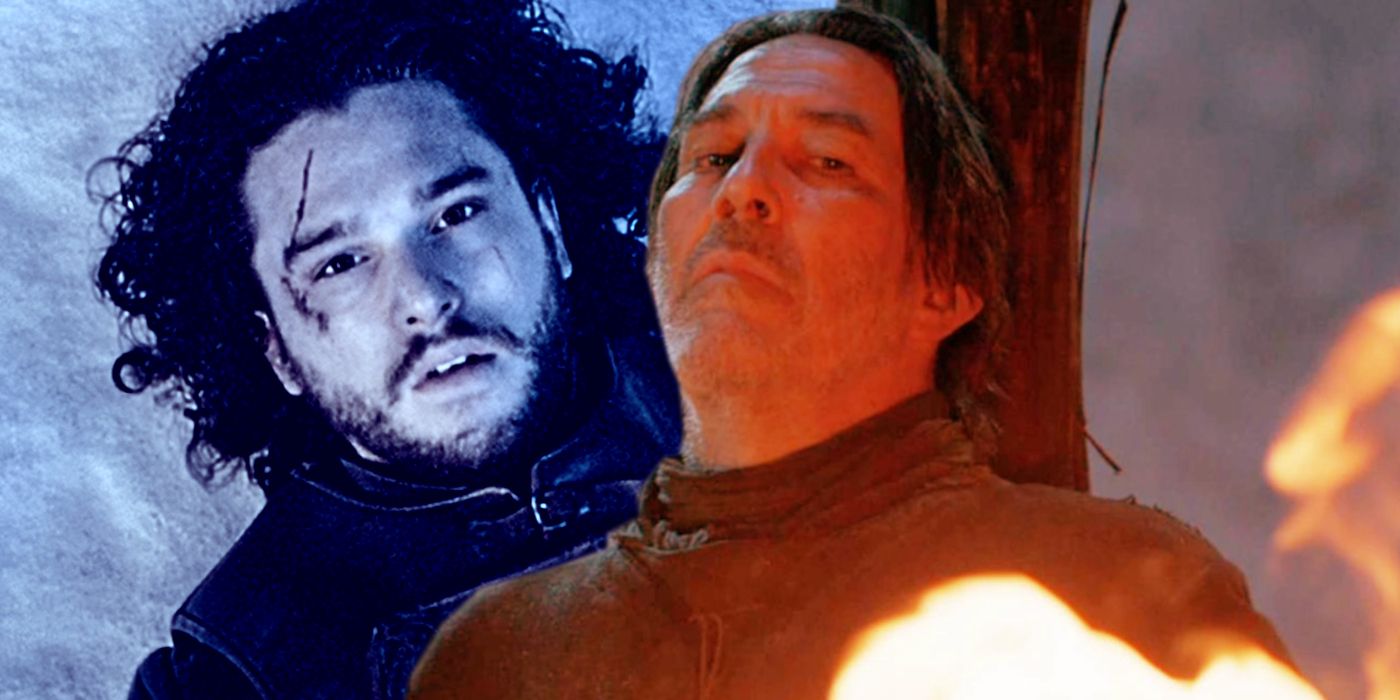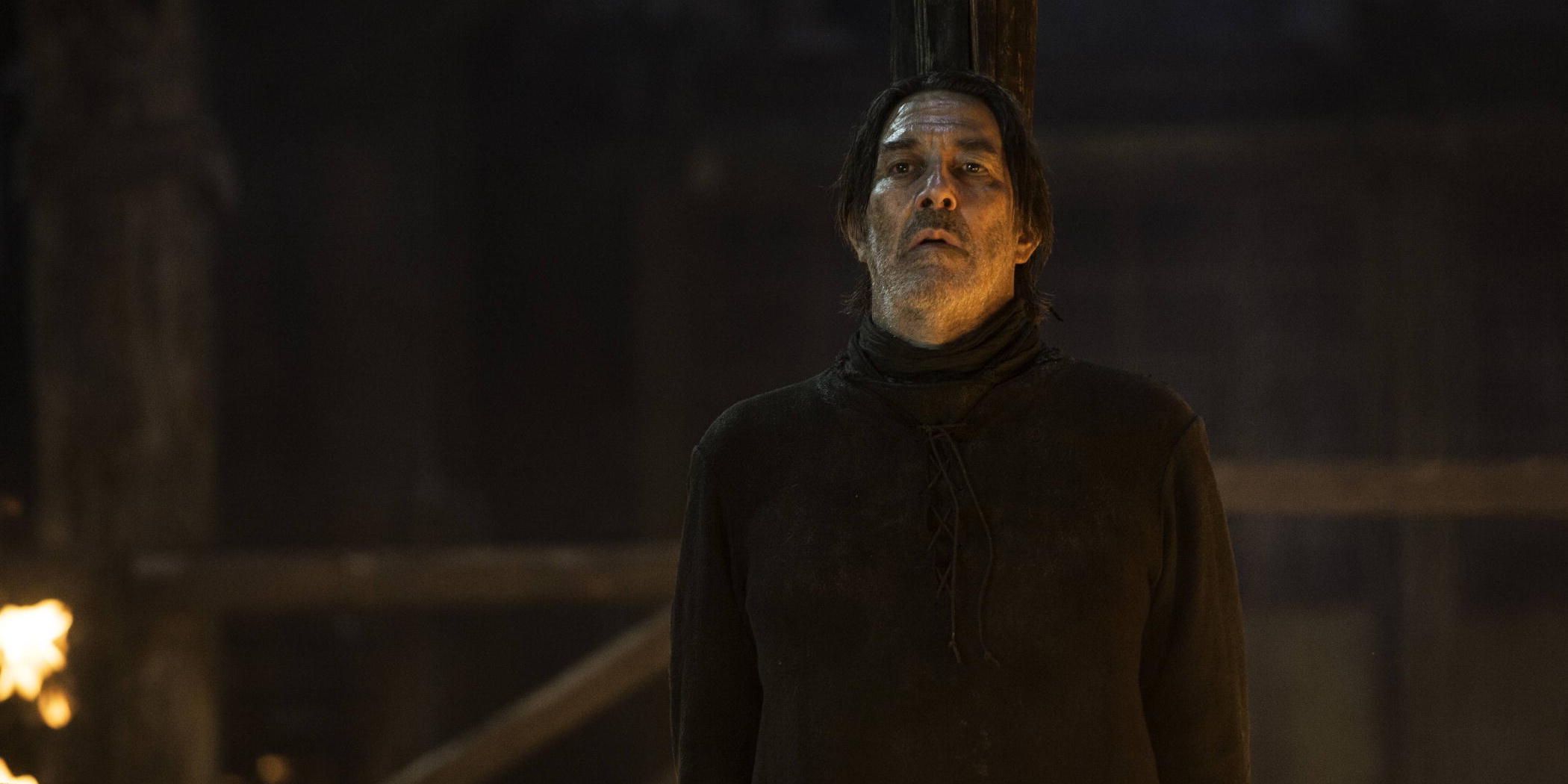Jon Snow's death at the hands of his brothers was Game of Thrones' biggest Night's Watch twist, but another shocking book moment, which concerned Mance Rayder, was cut. For viewers not familiar with George R.R. Martin's A Song of Ice and Fire books, Jon Snow's death was one of Game of Thrones' biggest twists. But while Jon somewhat inevitably came back, there was already another character "killed" at the Wall who had made a surprising return in the books: the King-Beyond-the-Wall, Mance Rayder.
In both Game of Thrones and A Dance with Dragons, Stannis orders Mance to be killed after his arrival at the Wall, due to Mance refusing to bend the knee. Similarly, in both versions Mance is to be burned alive, only to be given a swifter, more merciful death thanks to Jon Snow. That's where the story diverges though, because it's the end of Mance Rayder in Game of Thrones, but not A Song of Ice and Fire. Later in A Dance with Dragons, it's revealed the man actually killed was Rattleshirt, aka the Lord of Bones, who had been glamored by Melisandre's magic to appear as Mance, and vice versa. Game of Thrones did no such thing: Rattleshirt was just himself, eventually killed (and presumably re-animated) at Hardhome, while Mance Rayder truly was dead, and that fits with how the show made big changes (and cuts) to the plot at this point.
The reason Mance is spared is so that he can be sent to Winterfell to rescue Arya Stark from Ramsay Bolton, who has her held hostage and intends to marry her to bolster his claim to the North. Jon is eventually told of this plan, and Mance infiltrates Winterfell under the guise of a bard named Abel, along with six of his spearwives. In this version, Arya is actually Jeyne Poole, an old friend of Sansa's, who is eventually rescued by Theon Greyjoy, while Mance is said to have been captured in a letter supposedly from Ramsay to Jon. Game of Thrones changed this almost entirely, deciding to completely streamline the plot: instead of Arya/Jeyne, it sent Sansa to be wed to Ramsay, cutting down her own story in the Vale. The letter from Ramsay to Jon, meanwhile, arrives after his death and resurrection, rather than before it.
Aside from simply condensing things down in order to fit the approximately 70-hours they were aiming to tell the entire story in, there are a few other clear reasons in why this particular Night's Watch twist was cut. Although it works on the page, it is somewhat convoluted, and may not have translated as well to TV screens, especially because it involves so many other characters who were either not fleshed out or never even introduced, including a child of Mance's who doesn't make it into the show (and is involved in another identity-swap story). With things building not only to Jon's death but also his return, then presumably the showrunners felt that doing this with another character in the same storyline would have diluted the impact of Jon's resurrection, which was a major factor in why Game of Thrones cut Lady Stoneheart as well.
As well as limiting the number of resurrections, this also fits with how Game of Thrones tended to avoid magic where possible. A Song of Ice and Fire may take cues from historical epics and have lots of war and politics, but it's also a massive fantasy story, and magic is a crucial part of this world. Game of Thrones included magic, but tended to scale it back, preferring instead to focus on the more grounded elements (and dragons). Melisandre's glamor would not only have been using more magic where the story perhaps didn't need it, but it's also possible that it was felt it could undercut the reveal of another piece of glamor magic, when Melisandre is unveiled as an old woman in Game of Thrones season 6.
Finally, there are the more wholesale changes to this story: Jeyne Poole becomes Sansa because the latter is a character viewers are invested in, and means no screen time had to be "wasted" in developing a more minor player such as Jeyne. That does make some sense, although Sansa's wedding arc didn't play out at all well, with Ramsay raping the character a low-point of the entire show.Even with Mance, that wouldn't have been much better, as such horrible acts and more befall Jeyne in the books. Stannis' arc, too, is cut down as the show quickly ends his own battle with Ramsay, instead saving room for the Battle of the Bastards to come, allowing a similar net result in a much quicker way. And the show does give Mance a good death, as his conversation with Jon helps cement their bond, adding further weight to Jon Snow going back North of the Wall at the end of Game of Thrones. But as a storyline full of intrigue and mystery, it is unfortunate that elements of it had to be lost.


